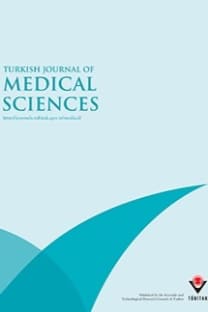Circulating miR-29c-3p is downregulated in patients with acromegaly
Circulating miR-29c-3p is downregulated in patients with acromegaly
___
- 1. Akirov A, Asa SL, Amer L, Shimon I, Ezzat S. The clinicopathological spectrum of acromegaly. Journal of Clinical Medicine 2019; 8 (11): 1962. doi: 10.3390/jcm8111962
- 2. Feng Y, Mao ZG, Wang X, Du Q, Jian M et al. MicroRNAs and target genes in pituitary adenomas. Hormone and Metabolic Research 2018; 50 (3): 179-192. doi: 10.1055/a-0585-7410
- 3. Mao ZG, He DS, Zhou J, Yao B, Xiao WW et al. Differential expression of microRNAs in GH-secreting pituitary adenomas. Diagnostic Pathology 2010; 5: 79. doi: 10.1186/1746-1596-5-79
- 4. Di Ieva A, Butz H, Niamah M, Rotondo F, De Rosa S et al. MicroRNAs as biomarkers in pituitary tumors. Neurosurgery 2014; 75 (2): 181-189. doi: 10.1227/NEU.0000000000000369
- 5. Katznelson L, Laws ER Jr, Melmed S, Molitch ME, Murad MH et al. Acromegaly: an endocrine society clinical practice guideline.The Journal of Clinical Endocrinology & Metabolism 2014; 99 (11): 3933-3951. doi: 10.1210/jc.2014-2700
- 6. Shi X, Tao B, He H, Sun Q, Fan C et al. MicroRNAs-based network: a novel therapeutic agent in pituitary adenoma. Medical Hypotheses 2012; 78 (3): 380-384. doi: 10.1016/j. mehy.2011.12.001
- 7. Fang R, Huang Y, Xie J, Zhang J, Ji X. Downregulation of miR29c-3p is associated with a poor prognosis in patients with laryngeal squamous cell carcinoma. Diagnostic Pathology 2019; 14 (1): 109. doi: 10.1186/s13000-019-0893-2
- 8. Chen G, Zhou T, Li Y, Yu Z, Sun L. p53 target miR-29c-3p suppresses colon cancer cell invasion and migration through inhibition of PHLDB2. Biochemical and Biophysical Research Communications 2017; 487 (1): 90-95. doi: 10.1016/j. bbrc.2017.04.023
- 9. Wu H, Zhang W, Wu Z, Liu Y, Shi Y et al. miR-29c-3p regulates DNMT3B and LATS1 methylation to inhibit tumor progression in hepatocellular carcinoma. Cell Death & Disease 2019; 10 (2): 48. doi: 10.1038/s41419-018-1281-7
- 10. Yan HJ, Ma JY, Wang L, Gu W. Expression and significance of circulating microRNA-31 in lung cancer patients. Medical Science Monitor 2015; 21: 722-726. doi: 10.12659/MSM.893213
- 11. Shen K, Cao Z, Zhu R, You L, Zhang T. The dual functional role of MicroRNA-18a (miR-18a) in cancer development. Clinical and Translational Medicine 2019; 8 (1): 32. doi: 10.1186/ s40169-019-0250-9
- 12. Humphreys KJ, McKinnon RA, Michael MZ. miR-18a inhibits CDC42 and plays a tumour suppressor role in colorectal cancer cells. PLoS One 2014; 9 (11): e112288. doi: 10.1371/journal. pone.0112288
- 13. Liang C, Zhang X, Wang HM, Liu XM, Zhang XJ et al. MicroRNA-18a-5p functions as an oncogene by directly targeting IRF2 in lung cancer. Cell Death & Disease 2017; 8 (5) :e2764. doi: 10.1038/cddis.2017.145
- 14. Giustina A, Chanson P, Bronstein MD, Klibanski A, Lamberts S et al. A consensus on criteria for cure of acromegaly. The Journal of Clinical Endocrinology & Metabolism 2010; 95 (7): 3141-3148. doi: 10.1210/jc.2009-2670
- 15. Valassi E, García-Giralt N, Malouf J, Crespo I, Llauger J et al. Circulating miR-103a-3p and miR-660-5p are associated with bone parameters in patients with controlled acromegaly. Endocrine Connections 2019; 8 (1): 39-49. doi: 10.1530/EC18-0482
- 16. Zhao S, Li J, Feng J, Li Z, Liu Q et al. Identification of Serum miRNA-423-5p expression signature in somatotroph adenomas. International Journal of Endocrinology 2019. doi: 10.1155/2019/8516858
- 17. Hudcova K, Raudenska M, Gumulec J, Binkova H, Horakova Z et al. Expression profiles of miR-29c, miR-200b and miR-375 in tumour and tumour-adjacent tissues of head and neck cancers. Tumor Biology 2016; 37 (9): 12627-12633. doi: 10.1007/ s13277-016-5147-2
- 18. Bates PR, Carson MN, Trainer PJ, Wass JA, UK National Acromegaly Register Study Group (UKAR-2). Wide variation in surgical outcomes for acromegaly in the UK. Clinical Endocrinology 2008; 68 (1): 136-142. doi: 10.1111/j.1365- 2265.2007.03012.x
- 19. Melmed S, Bronstein MD, Chanson P, Klibanski A, Casanueva FF et al. A Consensus Statement on acromegaly therapeutic outcomes. Nature Reviews Endocrinology 2018; 14 (9): 552- 561. doi: 10.1038/s41574-018-0058-5
- 20. Paragliola RM, Corsello SM, Salvatori R. Somatostatin receptor ligands in acromegaly: clinical response and factors predicting resistance. Pituitary 2017; 20 (1): 109-115. doi: 10.1007/ s11102-016-0768-4
- 21. Ben-Shlomo A, Melmed S. Somatostatin agonists for treatment of acromegaly. Molecular and Cellular Endocrinology 2008; 286 (1-2): 192-198. doi: 10.1016/j.mce.2007.11.024
- 22. Capatina C, Wass JA. 60 years of neuroendocrınology: Acromegaly. Journal of Endocrinology 2015; 226 (2): T141-T160. doi: 10.1530/JOE-15-0109
- ISSN: 1300-0144
- Yayın Aralığı: Yılda 6 Sayı
- Yayıncı: TÜBİTAK
Increased incidence of malignancy in patients with primary hyperparathyroidism
Mustafa KULAKSIZOĞLU, Mustafa CAN, İlker ÇORDAN, Muhammet KOCABAŞ, Melia KARAKÖSE, Hatice ÇALIŞKAN BURGUCU, Feridun KARAKURT
Nur CANPOLAT, Haluk Burçak SAYMAN, Rahşan ÖZCAN, Mirzaman HUSEYNOV, Şenol EMRE, Haluk EMİR, Sebuh KURUĞOĞLU, Mehmet ELİÇEVİK, Yunus SÖYLET, Cenk BÜYÜKÜNAL
Tufan EGELİ, Güle ÇINAR, Tuğba YANIK YALÇIN, Yaşar BAYINDIR, Alpay ARI, Özlem AZAP, Hatice ÇABADAK, Oya Özlem EREN KUTSOYLU, Elif Mükime SARICAOĞLU, Yasemin TEZER TEKÇE, Adem KÖSE, Filiz KIZILATEŞ, Kübra DEMİR ÖNDER, Hikmet Eda ALIŞKAN, Yeşim UYGUN KIZMAZ, Ebru KURŞUN, Mehmet HABERAL, Yurdagül ALBAY
Şerife Şeyma TORĞUTALP, Feza KORKUSUZ, Ömer ÖZKAN, Kader Karlı OĞUZ, Şafak PARLAK
Ahmet Hakan ÜNLÜ, Esra GÜRBÜZ, Abdurrahman EKİCİ, Hasan YILMAZ
İsmet TOPÇU, Özge YILMAZ, Hasan YÜKSEL, Adem YAŞAR, Arzu AÇIKEL
Nur CANPOLAT, Mehmet TAŞDEMİR, Özde Nisa TÜRKKAN, Nurver AKINCI, Cihangir AKGÜN, Fatma Lale SEVER, Nurdan YILDIZ, Harika ALPAY, Cengiz CANDAN, Ayşe BALAT, Cihangir AKGÜN, Gül ÖZÇELİK, Meryem BENZER, Seha Kamil SAYGILI, Emine Neşe ÖZKAYIN, Mehtap ÇELAKIL, Sevgi YAVUZ, Nilüfer GÖKNAR, İlmay BİLGE
Sezen ATASOY, Nur ÖZTEN KANDAŞ, Beyza GÖNCÜ, Sevde HASANOĞLU, Yunus KAYALI, Emrah YÜCESAN
Azmi TUFAN, Burak EREN, Feyza KARAGÖZ GÜZEY, Abdurrahim TAŞ, Tuğçe ÇAY, Bülent UYANIK, Eyüp ÇETİN, Mustafa ÖRNEK
